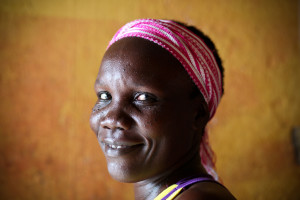By Allison Davis, Deputy Director of Programs
Not a lot of events bring together small-scale funders and grassroots women leaders, so it was quite a thrill and honor to be asked in January—on my first day as Global Greengrants’ deputy director of programs—to help coordinate such a meeting.
The Summit on Women and Climate is going to be true to the spirit of Global Greengrants, the International Network of Women Funds, and the Greengrants Alliance of Funds: no lectures, no Power Points, no panels. Rather, it will be a dynamic space for people to share, collaborate, and generate new insights on how to get more targeted funds to people on the front lines of change—women protecting our last remaining forests, reducing greenhouse gas emissions, and helping people adapt to a changing climate.
Funding around women’s roles & interests
In preparing for this Summit, I have learned a great deal from our advisors about how our grants are supporting women’s groups and interests all over the world.
Global Greengrants’ advisors’ networks distributes more than 700 small grants in more than 80 countries each year—providing sums of money that get to people working on a critical local issue at the time they most need it. We think that approximately 24 percent of these grants are actively supporting women-led organizations, and 11 percent are funding efforts that clearly approach differences in women’s roles and interests (6 percent of grants overlap into both categories).
 During the course of analyzing these grants, here are four themes that have risen to the top:
During the course of analyzing these grants, here are four themes that have risen to the top:
-
- Women are leaders in forest protection. Women have long histories as forest-product users and managers around the world—from collecting shea nuts in Mali to harvesting herbal plants for ayurvedic medicine in India. And our grants help strengthen women’s associations in their efforts to protect forests and their access to them.
- They are using innovative, peaceful protest tactics. Women are on the front lines of peaceful protests against the destruction of traditional territory. They need quick, responsive grants in timely increments that are sensitive to how women network between their associations. Read the story of a woman grantee in Indonesia who used peaceful tactics to successfully keep mines from destroying her culture, forest, and community.
- They are defending against urban carbon emissions. I am also proud of our grants to women activists working in cities to protest pollution and contamination. These organizations, sometimes led by women, are unsung heroes in some of the most toxic places on Earth. And people leading and participating in these groups are often motivated by how their families have been badly affected by pollution.
- Small grants can help build solidarity from the ground up. For environmental justice activists, large organizational grants don’t work in the formative years. Small grants are key to building solidarity in nascent movements, which can be so fragile. Too much money too soon is a clear mistake in funding small organizations. It takes people on the ground to really understand the dynamic and to suggest the right amount of funds.
I will expand on each of these themes in the weeks ahead; they are just a few of the topics that leaders funding women’s activism around the world will be talking about at the Summit. It will be an honor for me to be there to listen and learn from them, and I sincerely hope it will generate new momentum and collaboration between the women’s funds and environmental activists we are bringing together.
Click here to learn more about the Summit on Women & Climate. And stay up-to-date on women and climate news by following our tweets at #WomenAndClimate.
